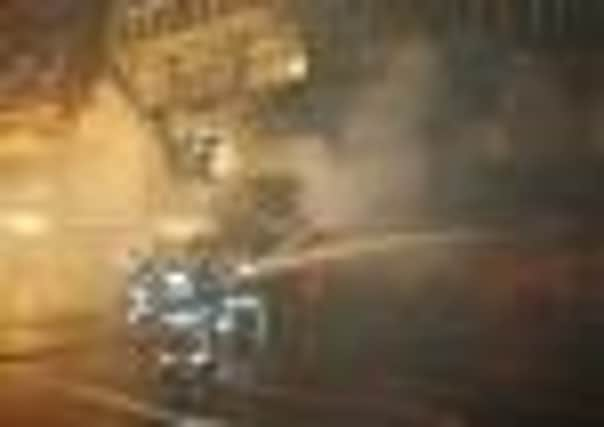The day Edinburgh burned: Cowgate Fire ten years on


Two minutes later, fire alarms began sounding in closed stores up and down South Bridge, with the first fire crews from Tollcross arriving on the scene moments later.
It was barely noticed by the crowds beginning to throng through the Cowgate. No hint that it would soon become the largest fire to hit any UK city in decades.
Advertisement
Hide AdAdvertisement
Hide AdA single spark from a faulty fuse box led to a blaze which engulfed 11 buildings and took crews 20 hours to bring under control. It took 52 hours to fully extinguish.


“It was a huge challenge, and had it not been for the heroic efforts of the firefighters, the damage could have been much, much worse,” recalls Donald Anderson, the long-standing council leader, woken at 3am to be told of the inferno taking hold of the Old Town.
“Had the fire broken through to Chambers Street, the damage would have been catastrophic.”
Battling the flames in the narrow wynds of the Cowgate, 80 firefighters fought to bring the blaze under control in buildings, some of which were constructed in the 1700s and largely devoid of modern safety measures.
The Gilded Balloon, La Belle Angele nightclub and the Bridge Jazz Bar were among the buildings to be swallowed up by flames which illuminated the night sky.


By 10pm, the fire had spread to several properties on the Cowgate and Lothian and Borders Fire and Rescue asked for help from neighbouring brigades. By midnight, the flames spread to Chambers Street and South Bridge and ten buildings were well alight.
An orange glow hung above the city and could be seen for miles around, including in Dunfermline, where one senior officer received a call to relieve exhausted ground crews at the scene.
“I remember it to this day”, says Dave Young, 58, then a divisional officer with Lothian and Borders Fire and Rescue.
Advertisement
Hide AdAdvertisement
Hide Ad“I was off that weekend and had been picking my son up from Dunfermline, but I could see the glow in the sky over Edinburgh. I already knew I’d be getting the call and made my way in about 3am. The fire was just an absolute nightmare. The most difficult technically I’ve ever been to. We stood on South Bridge and we had five floors below us and about four storeys above.
“We had crews inside the buildings who thought they were in a safe area and then realised the fire was raging above them. At one stage we had a crew moving through a narrow passageway and flames from a boarded-up lift poured out and threatened to cut half a dozen off from the main group. It had been boarded up years ago and they had no idea it was there.”
Lothian and Borders were said to have had the most advanced fire training in Scotland at the time, which fire chiefs partly credit for their ability to deal with the blaze.
“Our guys had plenty of experience but there’s a predictability about modern buildings. This was completely unpredictable,” adds Mr Young, who had been head of training at the brigade, and who retired two years ago.
By dawn on Sunday morning, a thick layer of acrid smoke hung over central Edinburgh but the fire continued to rage until 4pm that afternoon. It would be the next day before it was completely extinguished. Before then, fire chiefs were forced to pull back from the crumbling buildings and prevent the fire spreading up Adam House at Edinburgh University and on to ground-floor level at Chambers Street. Crews set up cordons and saturated the smoke-logged buildings for hours at time.
Edinburgh City Council placed 54 people, whose flats had been damaged or destroyed, in emergency accommodation while Edinburgh University rehoused 90 students.
Images and footage from the blaze, at the heart of the Unesco World Heritage Site, was beamed across the globe, and the authorities were inundated with calls from the media.
“We had two officers in HQ to deal with press from all over the world,” says Mr Young.
Advertisement
Hide AdAdvertisement
Hide Ad“Quite simply it was the largest fire any UK city has seen in decades. I served for 30 years, and my father was a firefighter in Edinburgh for 30 years before me, and he couldn’t remember a more ferocious blaze.
“There was a real worry that night, and the days that followed, that someone could get hurt. And there was a real worry that we couldn’t stop this.”
Bravery in aftermath
Donald Anderson, city council leader at the time of the blaze ten years ago, says: “I remember being in awe of the investigators who went into the fragile shell of the building to determine its cause in a building that
the council’s staff had declared unsafe. They were very brave.
“I described the fire as a ‘gaping wound in the heart of the city’, which is what it was, but the television coverage went worldwide in an instant. There were people from around the world who were convinced that the whole centre of Edinburgh had burnt down, and hotels had anxious calls from tourists asking if it was still OK to come to the city. We actually had to launch a campaign to ensure people knew that Edinburgh was
open for business.”
Stats
• 52 – The Cowgate fire broke out at 8pm on Saturday December 7, 2002. It was finally extinguished 52 hours later.
• 11 – At least 11 properties were destroyed
• £300k – the estimated cost of the operation. The clean-up operation which followed cost more than £1million
• 80 – Number of firefighters at the scene